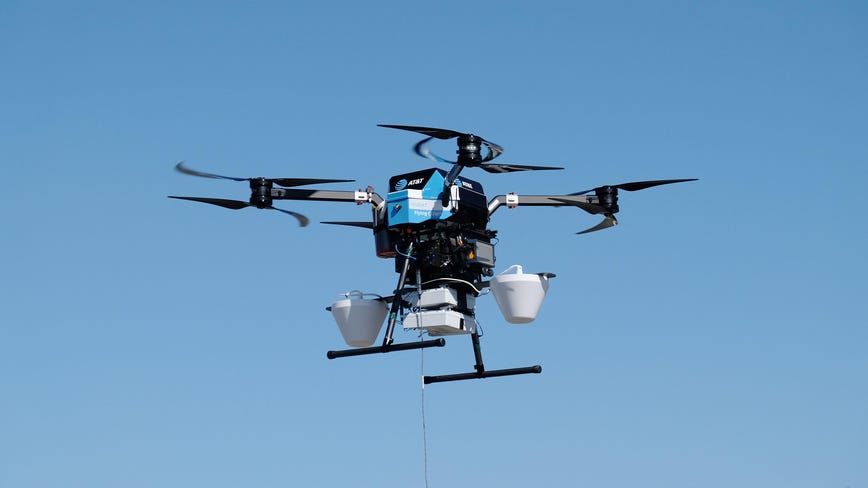
For the past few years, AT&T has provided cellular coverage at disaster sites around the U.S. They run the network behind FirstNet, a service for first responders. When their services are needed they typically provide this via trucks called COWs (cell on wheels).
In the more recent years, the carrier expanded to using a fleet of flying COWs (cell on wings). These flying COWs are drones that are capable of providing coverage to larger areas and are therefore more effective.
Just last month, AT&T started testing its first flying COWs with 5G service rather than LTE. Tests took place in a remote area of Missouri where no other services are available.
In an exclusive interview with CNET, Art Pregler, AT&T’s drone leader, said it was challenging to find a location without their service.
“We were trying to find an area where there was no signal at all so we could be assured that all the signal we were capturing was from our drone,” said Pregler.
As AT&T prepares their flying COWs to be available in about a month, they are also upgrading some fiber optic tethers. This is what links the drones to the trucks that serve as communication and power bases.
Pregler says the drones are staged in warehouses and ready for use now. He added, “We have them on the West Coast for fire season, in the Southeast for hurricane season and in the Midwest for flood season.”
With a focus more on coverage and availability over maximizing speeds, AT&T reported their first 5G flying COW test showed results of 10 square miles of coverage. This is with the drone hovering at 300 feet up. At this distance, the drone connected to a satellite and provided download speeds of 46Mbps and upload speeds of 71Mbps.
Pregler recalled the Hurricanes in 2017 and 2018 when they used the flying COWs to provide network service to first responders on the ground. He noted, “For a while we were the only network that was operational there at ground zero.”
Since 2018, both Verizon and T-Mobile have also invested in preparation for disasters. In 2021, Verizon debuted their large mobile 5G base station truck they named Thor. For T-Mobile, they currently use portable network vehicles, satellite cells on wheels and satellite cells on light trucks. The uncarrier is improving their operations now and adding backup generators for when there is loss of power.
AT&T expects they’ll be utilizing the high-frequency radio waves called millimeter wave, or mmWave. These frequencies allow for a larger increase in data transfer speeds. Though the range is shorter, they can see speeds beyond 1Gbps.
The flying COWs won’t use mmWave for connecting your smartphone but will use it to help strengthen the network overall, Pregler said. mmWave connections will allow multiple drones to connect via a sort of mesh network in the sky, which will extend the flying COW coverage.
There are six different ways that the COW technology itself can connect to the network. According to Pregler, this includes fiber optic links and satellites in low Earth orbit or higher in geostationary orbit.
As climate change continues to take its toll on the world, AT&T will keep implementing improvements and advances where possible. We can only hope that the other carriers will do so as well. Good news is that Verizon just announced how 5G can help detect and even prevent wildfires. According to the news article:
Minsait, a European company, is currently testing a solution that takes steps in this direction. Its system uses solar-powered, 360-degree cameras to look for smoke in a 2-kilometer range and uses sensors to detect conditions such as humidity, temperature, wind and dew point. The cameras are AI-enabled to analyze all the data at the edge and can transmit alerts as needed.

